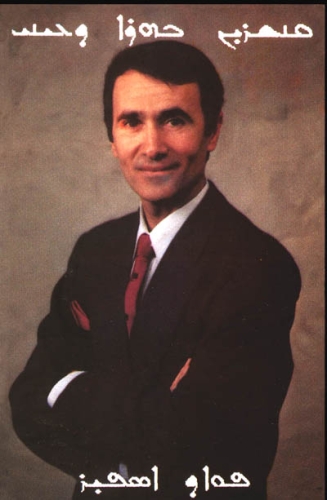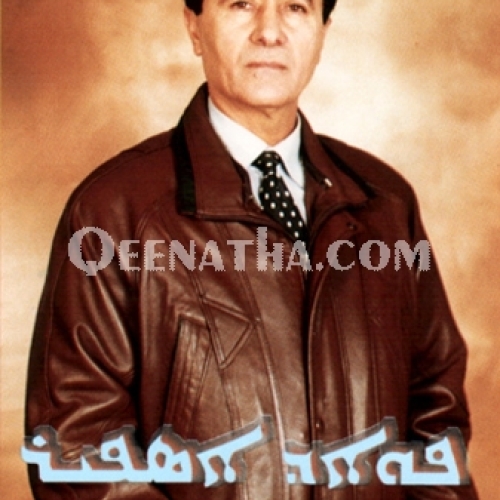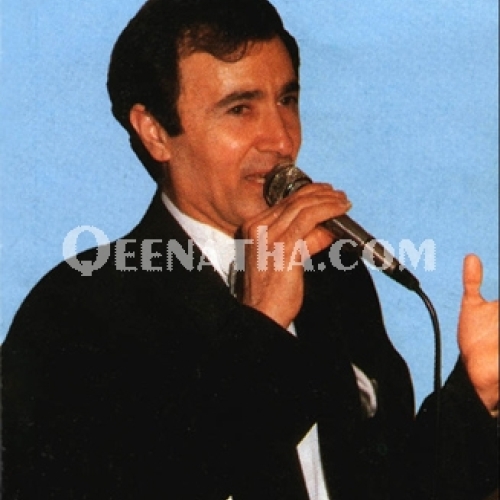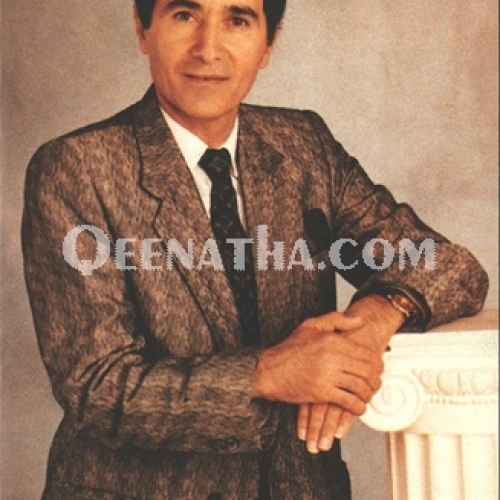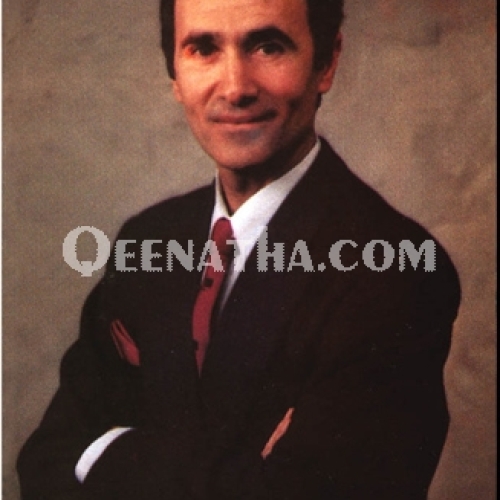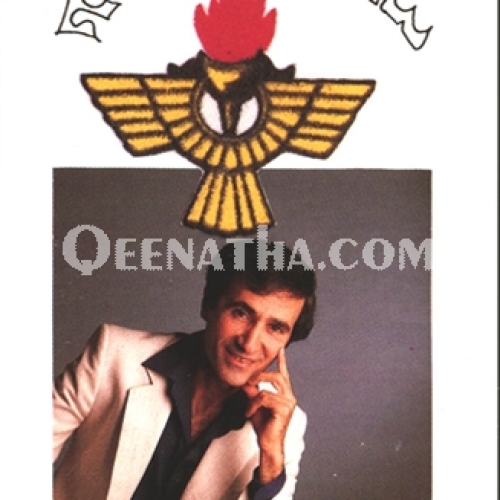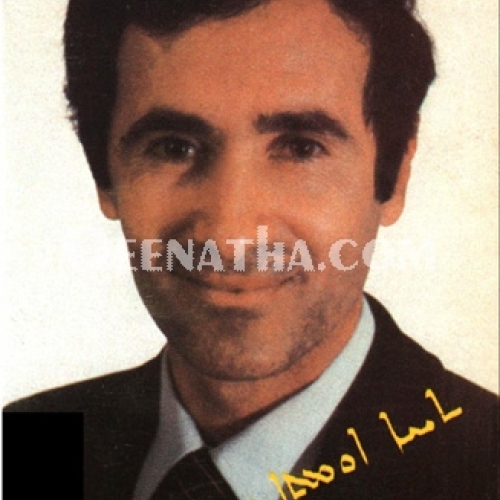Fuad Ispir
Details
- Artist Type
- Singer
- Biography
-
1942- 2012
Biography
Fuad Ispir
1942-2012
George Yousef, known as Fuad Ispir, was born 1942 in Qamishlo, son of Deacon AblahadYousef and KattushYousef. His parents’ origin was from KaÃ?¿biye, a village outside of Diyarbakir in southeastern Turkey that had a Christian Syriac Orthodox population until Seyfo 1915. His father survived the massacre at KaÃ?¿biye and fled after the difficult years to Qamishlo/Gozarto, northeastern Syria, to start a new life[1].
At a young age Fuad Ispir went to the Syriac Orthodox Church School in Qamishlo, where he learned church hymns and patriotic songs that were taught during that time by the deacon YusefShamun, the teachers EvlinDawud and JamileMaiilo[2], and other teachers of that era. At one point in the local St. Mary’s Church in 1957 (before the church’s renovation) young Fuad sang for his school class singing along with the peer student NuraShamun. They performed various patriotic songs in Syriac such as “Othkmo rom at”, “Moth Beth-Nahrin”, “Mothorḥimtonishodil” and “Taw netá¹Âayab”. Teachers and pupils at the school liked the performance and were surprised by Fuad’s talent, which motivated him to appear and sing at other occasions.
With the union between Syria and Egypt in 1958 a cultural center in Qamishlo opened where local youth interested in music could join and learn. At this cultural center Fuad Ispir met the composer Gabriel Asaad, the newly appointed music and theater manager of the center who was to give Fuad singing lessons. During this time, Gabriel Asaad was ordered, in his role as an official, by the Syrian authorities to do a tribute song in Arabic to the Union leader Gamal Abdel Nasser. This order resulted in composing the song “Ḥabib ash-shacbyaGamal”. Gabriel Asaad let the young Fuad to perform the song in various cultural events held in the cultural center. Fuad Ispir also performed in other venues in Qamishlo, some of which included scenes of the city cinemas (Shahrazad, Fuad and Garbis/Dimashq), and the Rafidayn Association. Fuad performed songs both in Arabic and Syriac during this period.
In 1960 Fuad went to Damascus with his music teacher to record “Ḥabib ash-shacbyaGamal”. They went to a studio that belonged to a radio station, but what they saw was something unexpected. The studio was being renovated and it was to be completed a month later. They could not stay for more than 10 days and returned home without any recording made[3]. Fuad used to tell this story to his friends.
Fuad Ispir continued to work with Gabriel Asaad in several concert appearances until 1962. The years 1962-63 Fuad served the compulsory military service. After military service, he worked for many years as a mechanic in Rmelan oil fields (petroleum) outside Ḥasake/Gozarto. Alongside the work Fuad also had a career as a football player in Rmelan’s football team in the 1960s[4]. He emigrated to Sweden in 1979.
It took nearly 20 years before Fuad returned to the music scene. In 1982 he participated in a music course held by the Assyrian Youth Association in Stockholm, which at that time had its premises in the suburb Hjulsta. In this course, which was led by his friend, the singer and composer Sardanapal Asaad, he was encouraged, also by many other friends, including Afrem Asaad, Aziz Poli, Gabriel Benjaro, Fahmi al-Qass, to start singing again. The music course led later to a party held in the suburb of Rinkeby. This performance was Fuad’s very first performance and comeback after so many years away from the music scene. It is noteworthy here to mention that with this relaunch Fuad Ispir sang for the first time in his people’s mother tongue, Surayt, which had become popular to sing in just about a decade before.
Fuad Ispir’s comeback performance
Rinkeby 1982-05-22
Fuad Ispir - vocals
Sardanapal Asaad - song, music director
Afrem Asaad - violin, contact man
Namrud Aho Gabriel - oud
Simon KavakçÃ?±oÃ?Â?lu (Besara) - synth
Fahmi al-Qass - saz
Nabil Sado - darbake
Nabil Shahin - daf
In the summer of the same year, 1982, a party was held in Sundbyberg with the singer HabibMousa, where Fuad Ispir was also present to sing. Soon after he continued with a party in Norsborg, where he came to meet old friends from the Rafidayn Association who remembered him singing in Qamishlo. Fuad was further encouraged by his friends to continue singing and his music career began to take off during this time.
In autumn 1983 he recorded his first music album in Stockholm with the Syriac Federation in Sweden as executive producer. The lyrics in this album were written by the poet Jan Lahdo. During this time Fuad appeared in many celebrations, accompanied by musicians like Toni HusniIshak (accordion), Faisal Bithoun (oud), Afram Safar (darbake), Joseph Malke (oud, accordion), Joseph Ibrahim Massi (oud), AdibMalke (darbake), Joseph Fathi (darbake) and others.
In June 1986 Fuad Ispir went to Istanbul together with the composer Joseph Malke to record a new album. This album, “Ḥubo d neshro”, contains Fuad Ispir’s most beloved song, “Tekhḥawro d ḥëlme”, written by the poet George Shamoun and composed by Joseph Malke. The album was a huge success and is widely seen as the best of Fuad Ispir's releases.
Fuad Ispir continued to improve his musical skills. He attended a new music course in autumn 1986 for musicians in the Syriac Orthodox Church in Hallonbergen, also this one led by Sardanapal Asaad. In this course Fuad learned various oriental scales such as Nahawand, Bayat, Husayni, Hijaz, HijazKar Kurd, Ã?¿Ajam, Rast, Segah etc. Fuad Ispir’s music is inspired by the classical school and has an oriental and original feeling. He was also inspired by the great Arab composer and singer Farid al-Atrash.
Fuad Ispir released totally six albums in Surayt. It is worth to mention here that Fuad Ispir’s native language was the Arabic dialect of KaÃ?¿biye[5]. Fuad knew little Surayt in Qamishlo, but it was not until his adulthood in Sweden during meetings with friends and of course through the singing that he learned to speak Surayt. Themes he sang about and came back to was love and the love for the Syriac/Aramaic heritage and the Syriac people. Many of his songs have remained popular among the youth and are standard songs in parties; “Waylokhzabno”, “Qenneshrinbahro d cayni”, “Ahnabnayo d Beth-Nahrin”, “Shlomo l kulkhun suryoye”. But the real pearls, in addition to the mentioned “Tekhḥawro d ḥëlme”, you will find if looking for something deeper are “Neshro”, “Yawno”, “Jrëḥlalebi w azzayo”, “Rbico d cumri w ḥayaydi”. Fuad was also known to have brought life into some old songs and thus made them available among the younger generations; these include beautiful songs such as Namrud Aho Gabriel’s “Kthuliëshmekhcalwardo” and George Chachan’s “Baytoshafirolatli” and “U lilyano”.
Other songs Fuad Ispir sang were written by Edward Ada, Jack Konstantin, HalefHalef, HapsunoBahho and close friend, the poet AbdelmasihShamoun, who used to help Fuad in editing the lyrics of his songs.
Fuad Ispir performed over the years at a lot of weddings and parties in Sweden and abroad. He also performed at a few concerts with the Syriac Music Choir in Hallunda and Södertälje in 2005 and 2009. The Syriac Music Choir, under the leadership of IssaHabil, held a tribute concert as recently as April this year in Södertälje in honor of Fuad Ispir’s music and lifework.
In 2009 Fuad Ispir participated in Suroyo TV’s popular program “Dore w yawmotho”, in the program about KaÃ?¿biye, where he paid tribute to his parents’ village with a song specially written for the program (in Arabic, by George Shamoun). Fuad Ispir used to appear and perform for the two TV channels Suroyo TV and Suryoyo Sat.
Fuad Ispir planned to record a seventh album, which his friend and musician Ninos Asaad helped to prepare. Unfortunately Fuad could not complete the album due to illness.
Fuad Ispir passed away on the evening of 10 September 2012 in StockholmsSjukhem and he was 70 years. He left behind a grieving family and a rich musical heritage. Many will remember his songs and his beautiful voice for years to come. He was loved by his people, his listeners, and by friends and loved ones.
It would be a great tribute to Fuad Ispir and to our music if the Syriac Federation in Sweden remasters his music, i.e. use the original master tapes for eventual re-release of the albums.
Hanibal Romanos
2012-09-19
Fuad Ispir Discography:
1 – 1983 – Tiḥeumthosuryoyto
2 – 1986 – Ḥubo d neshro
3 – 1988 – Qenneshrinbahro d cayni
4 – 1989 – Shlomoelakhothaydi
5 – 1994 – Urhoy
6 – 1999 – Shlomo w ḥubo
The first was recorded in Stockholm, all the others in Istanbul.
Sources: Fuad Ispir (2007), Sardanapal Asaad, AbdelmasihShamoun. The bulk of this biography is based on a shorter English version that I wrote for AbboudZeitoune’s music catalog Music Pearls of Beth-Nahrin, 2007.
[1] For more about the massacre in Ka�¿biye, see David Gaunt, Massacres, Resistance, Protectors: Muslim-Christian Relations in Eastern Anatolia During World War I, 2006, pages 230-231.
[2] Sister of singer and priest Jalil Maiilo.
[3] The song has never been recorded, but is preserved in musical notes.
[4]Rmelan’s football team was one of Syria's strongest teams during this time.
[5] This dialect is documented in SemitischesTonarchiv, University of Heidelberg
http://www.semarch.uni-hd.de/dokumentgruppen.php43?ST_ID=4&DT_ID=46
1942- 2012
Biography
Fuad Ispir
1942-2012
George Yousef, known as Fuad Ispir, was born 1942 in Qamishlo, son of Deacon AblahadYousef and KattushYousef. His parents’ origin was from KaÃ?¿biye, a village outside of Diyarbakir in southeastern Turkey that had a Christian Syriac Orthodox population until Seyfo 1915. His father survived the massacre at KaÃ?¿biye and fled after the difficult years to Qamishlo/Gozarto, northeastern Syria, to start a new life[1].
At a young age Fuad Ispir went to the Syriac Orthodox Church School in Qamishlo, where he learned church hymns and patriotic songs that were taught during that time by the deacon YusefShamun, the teachers EvlinDawud and JamileMaiilo[2], and other teachers of that era. At one point in the local St. Mary’s Church in 1957 (before the church’s renovation) young Fuad sang for his school class singing along with the peer student NuraShamun. They performed various patriotic songs in Syriac such as “Othkmo rom at”, “Moth Beth-Nahrin”, “Mothorḥimtonishodil” and “Taw netá¹Âayab”. Teachers and pupils at the school liked the performance and were surprised by Fuad’s talent, which motivated him to appear and sing at other occasions.
With the union between Syria and Egypt in 1958 a cultural center in Qamishlo opened where local youth interested in music could join and learn. At this cultural center Fuad Ispir met the composer Gabriel Asaad, the newly appointed music and theater manager of the center who was to give Fuad singing lessons. During this time, Gabriel Asaad was ordered, in his role as an official, by the Syrian authorities to do a tribute song in Arabic to the Union leader Gamal Abdel Nasser. This order resulted in composing the song “Ḥabib ash-shacbyaGamal”. Gabriel Asaad let the young Fuad to perform the song in various cultural events held in the cultural center. Fuad Ispir also performed in other venues in Qamishlo, some of which included scenes of the city cinemas (Shahrazad, Fuad and Garbis/Dimashq), and the Rafidayn Association. Fuad performed songs both in Arabic and Syriac during this period.
In 1960 Fuad went to Damascus with his music teacher to record “Ḥabib ash-shacbyaGamal”. They went to a studio that belonged to a radio station, but what they saw was something unexpected. The studio was being renovated and it was to be completed a month later. They could not stay for more than 10 days and returned home without any recording made[3]. Fuad used to tell this story to his friends.
Fuad Ispir continued to work with Gabriel Asaad in several concert appearances until 1962. The years 1962-63 Fuad served the compulsory military service. After military service, he worked for many years as a mechanic in Rmelan oil fields (petroleum) outside Ḥasake/Gozarto. Alongside the work Fuad also had a career as a football player in Rmelan’s football team in the 1960s[4]. He emigrated to Sweden in 1979.
It took nearly 20 years before Fuad returned to the music scene. In 1982 he participated in a music course held by the Assyrian Youth Association in Stockholm, which at that time had its premises in the suburb Hjulsta. In this course, which was led by his friend, the singer and composer Sardanapal Asaad, he was encouraged, also by many other friends, including Afrem Asaad, Aziz Poli, Gabriel Benjaro, Fahmi al-Qass, to start singing again. The music course led later to a party held in the suburb of Rinkeby. This performance was Fuad’s very first performance and comeback after so many years away from the music scene. It is noteworthy here to mention that with this relaunch Fuad Ispir sang for the first time in his people’s mother tongue, Surayt, which had become popular to sing in just about a decade before.
Fuad Ispir’s comeback performance
Rinkeby 1982-05-22
Fuad Ispir - vocals
Sardanapal Asaad - song, music director
Afrem Asaad - violin, contact man
Namrud Aho Gabriel - oud
Simon KavakçÃ?±oÃ?Â?lu (Besara) - synth
Fahmi al-Qass - saz
Nabil Sado - darbake
Nabil Shahin - daf
In the summer of the same year, 1982, a party was held in Sundbyberg with the singer HabibMousa, where Fuad Ispir was also present to sing. Soon after he continued with a party in Norsborg, where he came to meet old friends from the Rafidayn Association who remembered him singing in Qamishlo. Fuad was further encouraged by his friends to continue singing and his music career began to take off during this time.
In autumn 1983 he recorded his first music album in Stockholm with the Syriac Federation in Sweden as executive producer. The lyrics in this album were written by the poet Jan Lahdo. During this time Fuad appeared in many celebrations, accompanied by musicians like Toni HusniIshak (accordion), Faisal Bithoun (oud), Afram Safar (darbake), Joseph Malke (oud, accordion), Joseph Ibrahim Massi (oud), AdibMalke (darbake), Joseph Fathi (darbake) and others.
In June 1986 Fuad Ispir went to Istanbul together with the composer Joseph Malke to record a new album. This album, “Ḥubo d neshro”, contains Fuad Ispir’s most beloved song, “Tekhḥawro d ḥëlme”, written by the poet George Shamoun and composed by Joseph Malke. The album was a huge success and is widely seen as the best of Fuad Ispir's releases.
Fuad Ispir continued to improve his musical skills. He attended a new music course in autumn 1986 for musicians in the Syriac Orthodox Church in Hallonbergen, also this one led by Sardanapal Asaad. In this course Fuad learned various oriental scales such as Nahawand, Bayat, Husayni, Hijaz, HijazKar Kurd, Ã?¿Ajam, Rast, Segah etc. Fuad Ispir’s music is inspired by the classical school and has an oriental and original feeling. He was also inspired by the great Arab composer and singer Farid al-Atrash.
Fuad Ispir released totally six albums in Surayt. It is worth to mention here that Fuad Ispir’s native language was the Arabic dialect of KaÃ?¿biye[5]. Fuad knew little Surayt in Qamishlo, but it was not until his adulthood in Sweden during meetings with friends and of course through the singing that he learned to speak Surayt. Themes he sang about and came back to was love and the love for the Syriac/Aramaic heritage and the Syriac people. Many of his songs have remained popular among the youth and are standard songs in parties; “Waylokhzabno”, “Qenneshrinbahro d cayni”, “Ahnabnayo d Beth-Nahrin”, “Shlomo l kulkhun suryoye”. But the real pearls, in addition to the mentioned “Tekhḥawro d ḥëlme”, you will find if looking for something deeper are “Neshro”, “Yawno”, “Jrëḥlalebi w azzayo”, “Rbico d cumri w ḥayaydi”. Fuad was also known to have brought life into some old songs and thus made them available among the younger generations; these include beautiful songs such as Namrud Aho Gabriel’s “Kthuliëshmekhcalwardo” and George Chachan’s “Baytoshafirolatli” and “U lilyano”.
Other songs Fuad Ispir sang were written by Edward Ada, Jack Konstantin, HalefHalef, HapsunoBahho and close friend, the poet AbdelmasihShamoun, who used to help Fuad in editing the lyrics of his songs.
Fuad Ispir performed over the years at a lot of weddings and parties in Sweden and abroad. He also performed at a few concerts with the Syriac Music Choir in Hallunda and Södertälje in 2005 and 2009. The Syriac Music Choir, under the leadership of IssaHabil, held a tribute concert as recently as April this year in Södertälje in honor of Fuad Ispir’s music and lifework.
In 2009 Fuad Ispir participated in Suroyo TV’s popular program “Dore w yawmotho”, in the program about KaÃ?¿biye, where he paid tribute to his parents’ village with a song specially written for the program (in Arabic, by George Shamoun). Fuad Ispir used to appear and perform for the two TV channels Suroyo TV and Suryoyo Sat.
Fuad Ispir planned to record a seventh album, which his friend and musician Ninos Asaad helped to prepare. Unfortunately Fuad could not complete the album due to illness.
Fuad Ispir passed away on the evening of 10 September 2012 in StockholmsSjukhem and he was 70 years. He left behind a grieving family and a rich musical heritage. Many will remember his songs and his beautiful voice for years to come. He was loved by his people, his listeners, and by friends and loved ones.
It would be a great tribute to Fuad Ispir and to our music if the Syriac Federation in Sweden remasters his music, i.e. use the original master tapes for eventual re-release of the albums.
Hanibal Romanos
2012-09-19
Fuad Ispir Discography:
1 – 1983 – Tiḥeumthosuryoyto
2 – 1986 – Ḥubo d neshro
3 – 1988 – Qenneshrinbahro d cayni
4 – 1989 – Shlomoelakhothaydi
5 – 1994 – Urhoy
6 – 1999 – Shlomo w ḥubo
The first was recorded in Stockholm, all the others in Istanbul.
Sources: Fuad Ispir (2007), Sardanapal Asaad, AbdelmasihShamoun. The bulk of this biography is based on a shorter English version that I wrote for AbboudZeitoune’s music catalog Music Pearls of Beth-Nahrin, 2007.
[1] For more about the massacre in Ka�¿biye, see David Gaunt, Massacres, Resistance, Protectors: Muslim-Christian Relations in Eastern Anatolia During World War I, 2006, pages 230-231.
[2] Sister of singer and priest Jalil Maiilo.
[3] The song has never been recorded, but is preserved in musical notes.
[4]Rmelan’s football team was one of Syria's strongest teams during this time.
[5] This dialect is documented in SemitischesTonarchiv, University of Heidelberg
http://www.semarch.uni-hd.de/dokumentgruppen.php43?ST_ID=4&DT_ID=46

